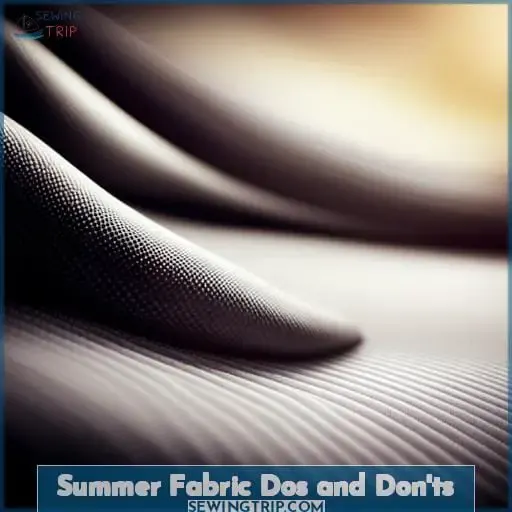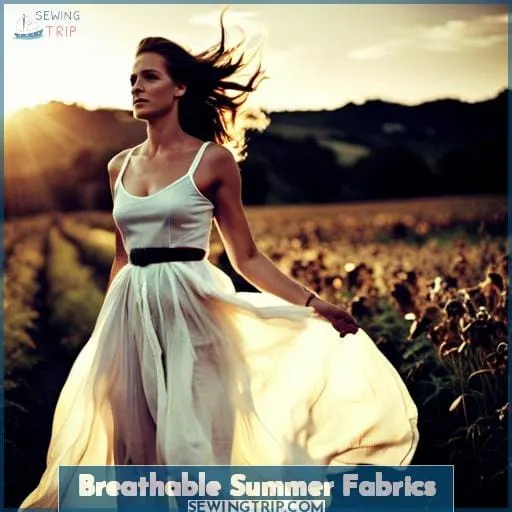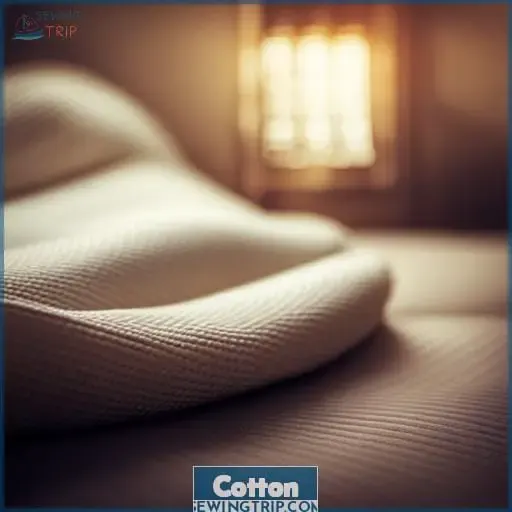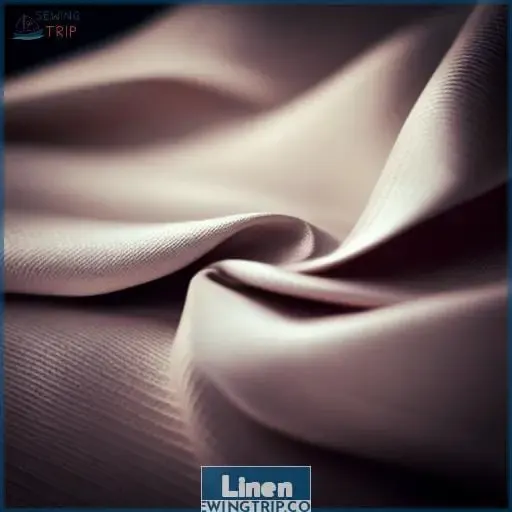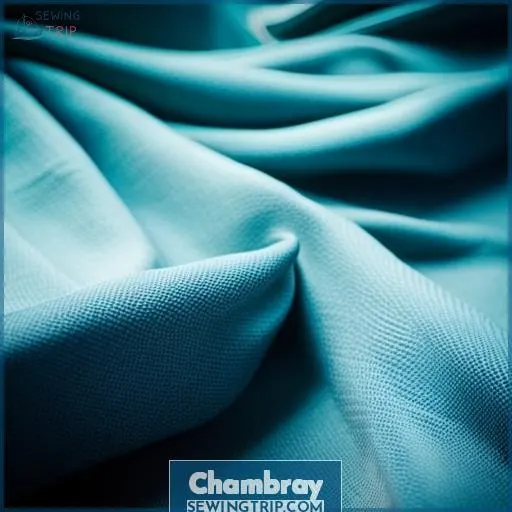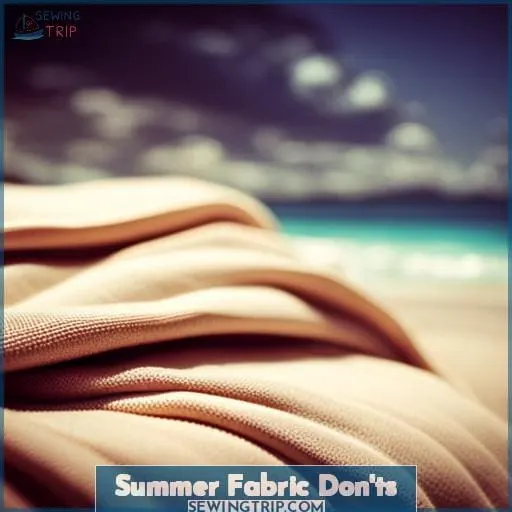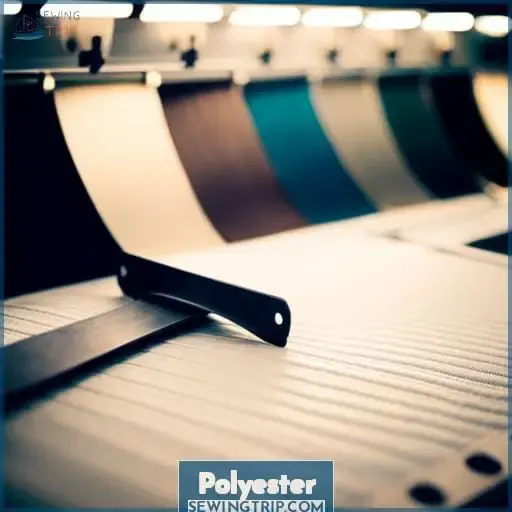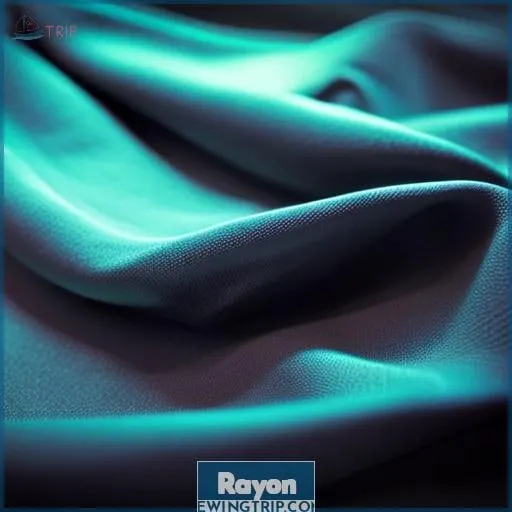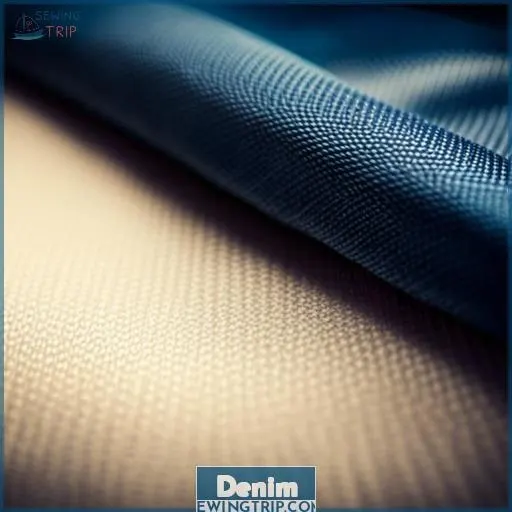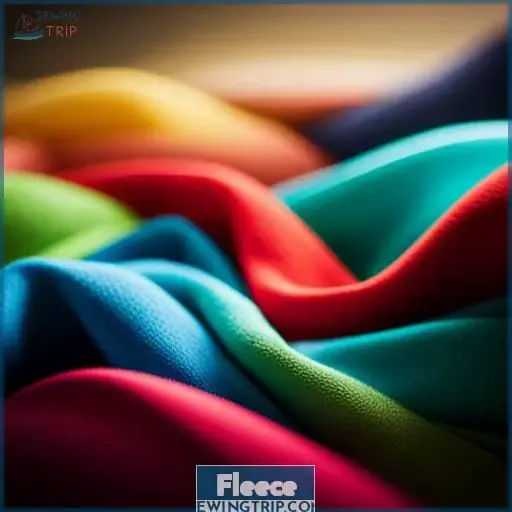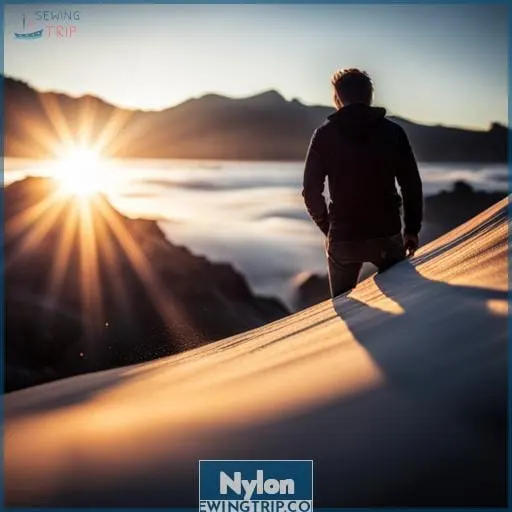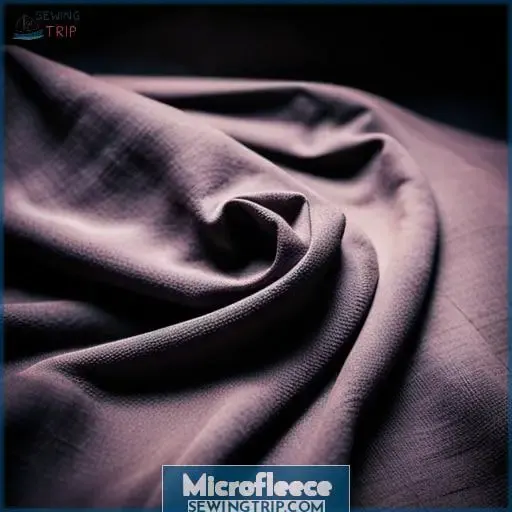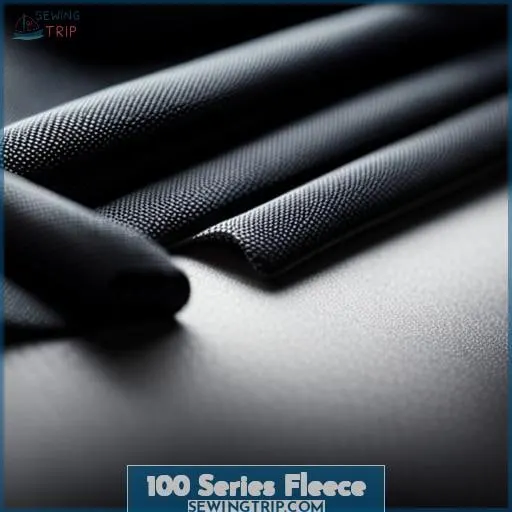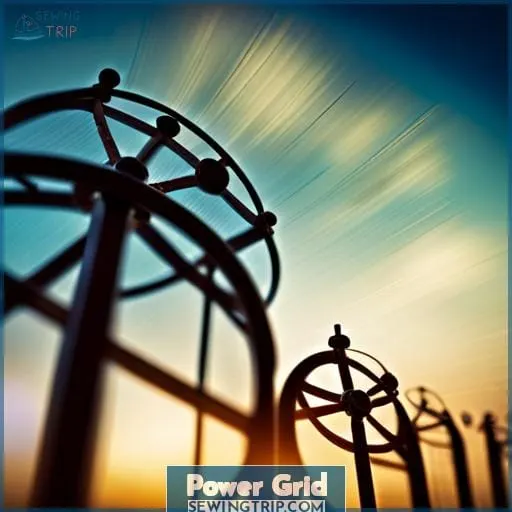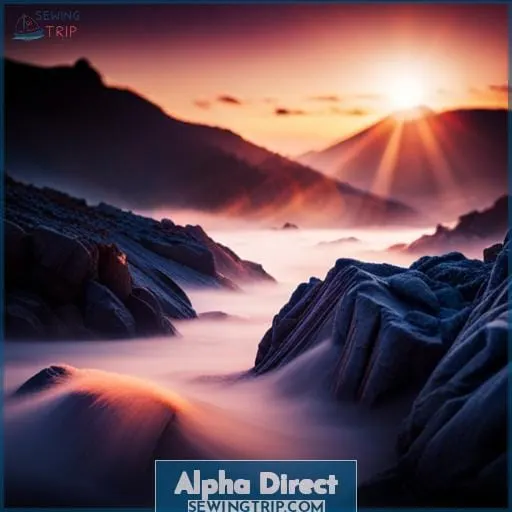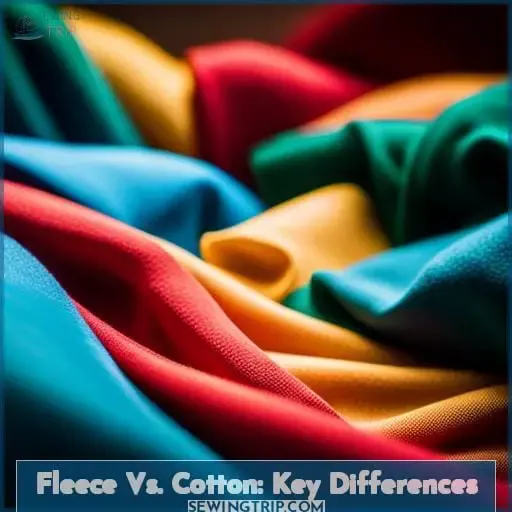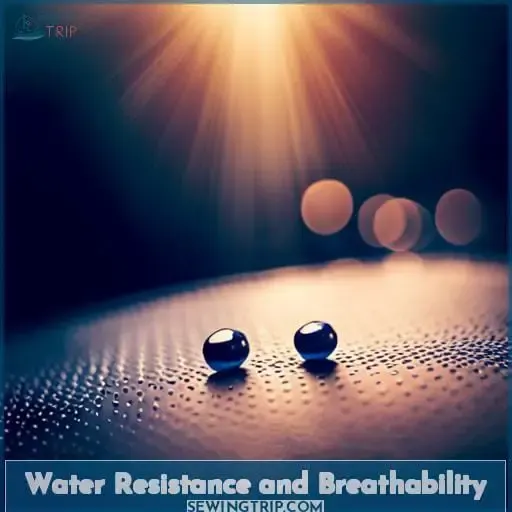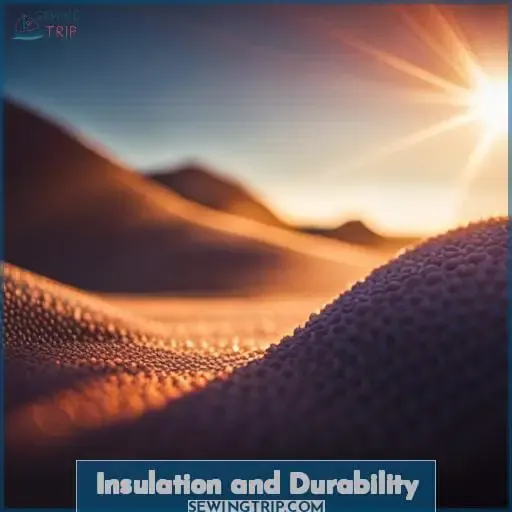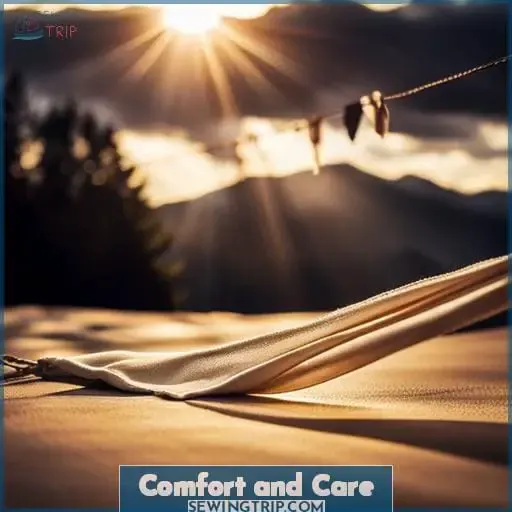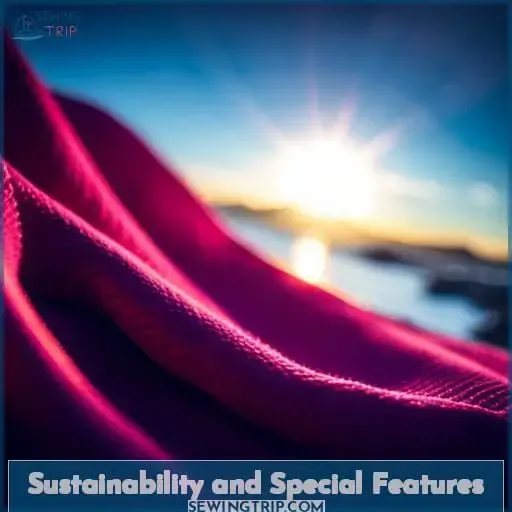This site is supported by our readers. We may earn a commission, at no cost to you, if you purchase through links.
 Is fleece breathable in hot weather?
Is fleece breathable in hot weather?
You’ve got plans to wear your fleece, but you’re worried about sweating.
We’re going to cover everything you need to know about the breathability of fleece, including which types are best for hot weather and how to style them so you can stay cool and comfortable.
We’ll also compare fleece to cotton, another popular summer fabric, so you can make an informed decision about which one is right for you.
Table Of Contents
- Key Takeaways
- Summer Fabric Dos and Don’ts
- Breathable Summer Fabrics
- Cotton
- Linen
- Silk
- Chambray
- Jersey
- Summer Fabric Don’ts
- Polyester
- Rayon
- Denim
- Fleece
- Leather
- Nylon
- Acrylic
- Summer Fleece Versatility
- Microfleece
- 100 Series Fleece
- Power Grid
- Alpha Direct
- Fleece Vs. Cotton: Key Differences
- Water Resistance and Breathability
- Insulation and Durability
- Comfort and Care
- Sustainability and Special Features
- Frequently Asked Questions (FAQs)
- Conclusion
Key Takeaways
- Silk, cotton, linen, chambray, and jersey are breathable summer fabrics that allow airflow and moisture absorption.
- Avoid polyester, rayon, denim, fleece, and leather in hot weather due to their poor breathability and moisture-wicking properties.
- Summer fleece is versatile for camping, backpacking, and cool nights, offering warmth at night and breathability during the day.
- Summer fleece provides UPF protection from harmful UV rays, allowing for outdoor activities without compromising skin health.
Summer Fabric Dos and Don’ts
You’ll want to pick fabrics that allow your skin to breathe during summer.
Let’s dive into the world of summer fabrics, exploring the dos and don’ts to keep you cool and comfortable.
Start with breathable fabrics like cotton, linen, silk, chambray, and jersey. These natural fibers let your skin breathe, wicking away sweat and keeping you fresh.
Embrace lightweight layering with these fabrics for versatile outfits that adapt to changing temperatures.
Avoid fabrics like polyester, rayon, denim, fleece, leather, nylon, and acrylic.
These materials trap heat, causing discomfort and sweat patches.
Opt for chambray instead of denim, and consider lightweight, loose-fitting leather items.
Embrace athleisurewear materials that prioritize breathability and moisture-wicking properties.
Breathable Summer Fabrics
By opting for breathable summer fabrics like cotton, linen, silk, chambray, and jersey, you can keep comfy and cool.
These fabrics allow air to circulate, wick away moisture, and prevent sweat buildup, ensuring you stay fresh and dry all day.
Cotton, a natural fiber, is renowned for its breathability and moisture absorption. It’s soft, lightweight, and versatile, making it ideal for various summer outfits.
Linen, another natural choice, is loosely woven, allowing for excellent airflow and preventing the fabric from clinging to your skin.
Silk, a luxurious fabric, is lightweight and weightless, adjusting to your body temperature to keep you cool in the heat.
Chambray, a plain-weave fabric, is lightweight and breathable, with darker shades effectively absorbing sweat.
Jersey, a knit fabric, provides flexibility and comfort, making it a popular choice for casual summer wear.
Cotton
Let’s shift our focus from the breezy linen to the timeless allure of cotton, a fabric that’s as versatile as it’s breathable.
Cotton, a natural plant-based fiber, is renowned for its softness, breathability, and impressive moisture absorption.
Whether you’re navigating sweltering city streets or embarking on coastal adventures, cotton’s inherent properties ensure you remain cool and comfortable all day long.
However, it’s worth noting that cotton tends to wrinkle easily, so if you’re seeking a crisp, polished look, you might want to opt for a blend or consider ironing your cotton garments.
And while cotton comes in a delightful array of colors, lighter shades are generally preferred for summer as they reflect heat more effectively.
So, embrace the comfort and breathability of cotton this summer, and enjoy the freedom of movement and effortless style it offers.
Linen
Linen’s loose weave absorbs moisture, ensuring you stay sweat-free on hot days.
This natural fiber doesn’t stick to your body, allowing air to circulate and keeping you cool.
Unlike synthetic fabrics that trap sweat, linen wicks moisture away from your skin, helping you regulate your body temperature.
Linen’s breathability makes it ideal for summer clothing, from breezy dresses to lightweight pants.
Its natural texture and subtle sheen add a touch of elegance to any outfit.
Linen’s durability ensures your garments will last for seasons, becoming softer with every wash.
Whether you’re lounging at home or exploring a new city, linen’s comfort and breathability will keep you feeling fresh and confident all day long.
Silk
You’ll next want to try silk, another breathable, lightweight fabric.
Its temperature-adjusting properties make it ideal for summer.
Its weightless feel and ability to adjust to your body temperature ensure comfort even on the hottest days.
Breathability: Silk’s natural fibers allow air to circulate, keeping you cool and comfortable.
Moisture-Wicking: Silk effectively wicks moisture away from your skin, preventing sweat stains and keeping you dry.
Temperature-Adjusting: Silk’s unique properties help regulate your body temperature, keeping you cool in the summer and warm in the winter.
Smooth and Soft: Silk’s smooth texture and luxurious feel against your skin provide unmatched comfort, making it a popular choice for summer garments.
Chambray
If you’re seeking a lightweight and breathable fabric for summer, chambray’s plain weave and higher thread count offer exceptional breathability.
This fabric’s loose construction allows air to circulate, keeping you cool and comfortable even on the hottest days.
Chambray’s versatility extends beyond its breathability; it’s also incredibly stylish.
Its unique texture and subtle sheen add a touch of sophistication to any outfit, making it perfect for both casual and formal settings.
Whether you’re styling a chambray shirt with jeans for a relaxed weekend look or pairing it with a skirt for a night out, this fabric’s versatility ensures you’ll always look and feel your best.
Ditch the heavy, sweat-inducing fabrics like nylon, acrylic, and rayon this summer and embrace the airy comfort of chambray.
Jersey
For a flexible, comfy choice, try jersey’s natural stretch.
In the realm of summer fabrics, jersey shines as a versatile hero. Its knit construction grants a flexible embrace that moves with you, never constricting your freedom. Revel in the comfort of jersey, a fabric that feels like a second skin, caressing your body with its soft touch.
Breathability takes center stage with jersey. Its airy weave allows air to circulate freely, wicking away sweat to keep you cool and dry. Whether you’re conquering workouts or navigating city streets, jersey’s breathability ensures you stay fresh and confident.
Unlike its synthetic counterparts, jersey embraces your body’s natural temperature regulation, preventing overheating and clamminess.
Jersey’s versatility extends beyond its functional merits. Its rich history in fashion grants it a timeless appeal. From casual tees to elegant dresses, jersey adapts seamlessly to various styles. Its drape flatters your form, accentuating your silhouette without sacrificing comfort.
Summer Fabric Don’ts
Steer clear of fabrics like polyester, rayon, denim, and fleece for summer outfits.
Steer clear of synthetic fabrics like polyester and nylon, which don’t breathe and trap heat, amplifying sweat.
Avoid moisture-wicking fabrics like rayon, as they’ll show sweat patches.
Denim, a heavyweight fabric, causes chafing and increases sweat.
Fleece, derived from polyester, traps moisture and prevents ventilation.
Instead, opt for natural fabrics like cotton and linen. These fabrics breathe well, allowing air to circulate and keeping you cool.
Cotton’s moisture-wicking properties pull sweat away from your skin, while linen’s loose weave allows for maximum airflow.
For outdoor activities, consider summer-weight fleece, designed for breathability and warmth.
Choose breathable fabrics that wick moisture, allowing you to stay cool and comfortable in hot weather.
Polyester
Say goodbye to polyester, the culprit behind sweat patches and uncomfortable summer days.
A synthetic material, it traps sweat, causing discomfort and unsightly sweat patches.
Its low breathability makes it a poor choice for warm weather activities.
Polyester is water-resistant, but this very quality works against you in the summer.
It prevents sweat from evaporating, leaving you feeling damp and sticky.
Choosing breathable fabrics like cotton or linen allows your skin to breathe and helps wick away sweat, keeping you cool and comfortable.
If you must wear polyester, opt for a lightweight, breathable base layer to minimize sweat accumulation.
For outdoor adventures, consider layering with a breathable rain and wind protection layer, ensuring comfort without compromising functionality.
Soft shells, often made from breathable materials, offer a good balance of protection and breathability for various activities.
Rayon
Avoid rayon’s sweat-revealing cling. Its thin fibers don’t absorb moisture, making it an uncomfortable choice for summer. You’ll feel damp and sticky as sweat accumulates on the fabric, showing through your clothes.
Rayon’s water-repellent nature exacerbates this issue. Unlike breathable fabrics like cotton and linen that wick moisture away from the skin, rayon traps it, leading to a muggy microclimate against your skin.
This lack of breathability can cause discomfort and irritation, especially during physical activity or in hot weather.
Unlike moisture-wicking fabrics, rayon retains moisture, making it cling to your body and reveal sweat stains. It’s best to opt for breathable alternatives like cotton or linen that allow your skin to breathe and keep you feeling fresh.
Even though rayon is known for its suede-like fabric, its lack of breathability makes it unsuitable for summer. Instead, consider linen or chambray for a light, airy feel, or leather and denim for a more substantial, water-resistant outer layer in case of rain.
Denim
Unlike rayon, denim’s heavyweight fabric spells trouble in the heat. Its lack of breathability and stretchiness traps sweat, causing uncomfortable bum sweat and chafing.
Say goodbye to denim’s rigid discomfort and hello to chambray’s breezy comfort. Chambray’s lightweight, airy construction allows your skin to breathe, keeping you cool and sweat-free.
Chambray’s middle layer offers insulation without overheating, making it ideal for unpredictable summer weather.
Its water-resistant properties make it a great choice for light showers, while its breathability prevents clamminess.
Unlike denim, chambray’s breathability rivals even cotton, making it a summer staple.
Fleece
Though denim is a durable fabric, fleece is a synthetic material that traps moisture and prevents proper ventilation. This can lead to discomfort, sweat patches, and even chafing. If you’re looking for a breathable fabric for summer, fleece isn’t a good choice.
However, some fleece fabrics, like summer fleece, are designed to be more breathable than traditional fleece. These fabrics are often made with a looser weave and have a higher wicking ability, which helps to draw moisture away from the skin and keep you cool.
If you’re planning on layering up for a cool summer night, a lightweight fleece jacket can be a good option. Just be sure to choose one that’s made from a breathable fabric and that fits loosely so that air can circulate.
Another option is to look for fleece fabrics that are treated with odor-resistant finishes. These finishes can help to prevent the growth of bacteria, which can cause odors. If you’re planning on wearing fleece clothing for an extended period of time, such as on a camping trip, choosing an odor-resistant fabric can be a good idea.
Leather
You’ll want to avoid tight-fitting leather clothing in the summer, as it’ll trap heat and moisture, turning your outfit into a sauna.
Instead, opt for loose-fitting, lightweight leather pieces that allow your skin to breathe.
Vintage, loose-fitting, lightweight leather can be a stylish choice for summer.
Invest in leather accessories like belts, bags, and shoes to add a touch of edginess to your summer wardrobe without overheating.
Leather is durable and ages beautifully, making it a worthwhile investment for your summer style.
While leather is naturally water-resistant, avoid exposing it to excessive moisture to maintain its quality.
Proper care and conditioning can extend the lifespan of your leather items and keep them looking their best.
Nylon
Next, you’ll discover that nylon, a synthetic material that repels water, is commonly used in athleisurewear and can cause chafing due to its low breathability.
Nylon is a fabric that’s commonly used in athletic wear due to its moisture-wicking properties.
However, it’s important to note that nylon isn’t a breathable fabric.
This means that it doesn’t allow air to circulate, which can lead to chafing and odor retention.
If you’re looking for a breathable fabric that will keep you cool and comfortable during summer activities, nylon isn’t the best choice.
Instead, opt for natural fibers like cotton or linen, or moisture-wicking synthetics like polyester or spandex.
Acrylic
Unlike nylon, acrylic is a synthetic material that’s not only hot and abrasive but also falls short in the breathability department.
Its high moisture-wicking abilities are rendered useless by its water retention, making it a breeding ground for odor and chafing.
If you value comfort and breathability, acrylic is one of the worst fabrics you can choose.
Furthermore, acrylic’s synthetic nature can irritate sensitive skin, causing allergies and discomfort.
Its price range may be alluring, but the drawbacks far outweigh any potential savings.
Pilling is another common issue with acrylic, leading to a worn-out appearance over time.
If you seek breathable summer fabrics, steer clear of acrylic.
Invest in natural fibers like cotton and linen, or opt for moisture-wicking fabrics designed for breathability and comfort.
Your skin and your style will thank you.
Summer Fleece Versatility
When you’re outdoors during the summer, your fleece can keep you warm at night yet breathable during the day.
For summer activities like camping and backpacking, its lightweight and packable design makes it easy to carry and provides UPF protection.
Camping, Backpacking, Cool Nights
Your summer camping or backpacking trip gets a cozy companion in summer fleece.
Lightweight and packable, it offers warmth at night and breathability during the day.
Picture this: a starry sky, a crackling campfire, and you, wrapped in the comfort of summer fleece, embracing the great outdoors.
With moisture-wicking properties and UPF protection, it’s your versatile shield against the elements, keeping you comfortable and protected.
Warmth at Night, Breathability in Day
You’ll be able to stay cozy on cool nights and stay breezy during the day with the breathability of summer fleece.
Its moisture-wicking properties pull sweat away from your skin, while its breathability allows air to circulate, keeping you comfortable in fluctuating temperatures.
Summer fleece regulates your temperature, keeping you warm when it’s cool and cool when it’s warm, making it an ideal choice for outdoor activities, camping, and backpacking.
Lightweight, Packable
With its lightweight and packable nature, summer fleece becomes an ideal companion for your outdoor adventures.
Effortless Portability:
Its weightless construction allows you to easily pack it, making it a breeze to carry along.
Efficient Warmth Regulation:
Despite its lightweight design, summer fleece excels at regulating warmth, providing you with cozy comfort when temperatures drop.
Breathable and Moisture-Wicking:
Experience the best of both worlds with summer fleece. Its inherent breathability prevents overheating, while its moisture-wicking properties keep you dry and fresh.
UPF Protection:
Stay protected under the sun’s rays with summer fleece’s UPF protection, shielding your skin from harmful UV radiation.
UPF Protection
Fleece’s UPF protection shields your skin from the sun’s harmful rays, allowing you to embrace the summer sun without worry.
With the right fleece clothing, you can enjoy outdoor activities without compromising your skin’s health.
Various types of summer fleece offer UPF protection, ensuring you stay protected and comfortable even on the hottest days.
Microfleece
Microfleece feels buttery soft and offers breathable comfort thanks to its premium polyester yarns.
It’s a lightweight companion for outdoor activities, providing comfort and durability for a variety of occasions.
Examples include the REI Co-op – Trailsmith Fleece and the Athleta – Balance Microfleece Sweatshirt.
Buttery Soft, Breathable
Experience the luxurious softness and breathability of microfleece, your perfect companion for outdoor adventures.
Its buttery touch caresses your skin, while its advanced fibers ensure exceptional breathability.
Feel the gentle breeze against your skin as moisture wicks away, keeping you fresh and dry.
Discover the lightweight comfort of microfleece, allowing you to move freely and explore nature’s beauty without feeling weighed down.
Lightweight Companion
Microfleece is a trusty companion for outdoor adventures. It offers a lightweight layer that keeps you comfortable.
Its inherent breathability allows for efficient temperature regulation. Its moisture-wicking properties ensure you stay dry during strenuous activities.
Whether you’re backpacking through rugged terrains or enjoying a brisk hike, microfleece adapts to your body’s needs.
100 Series Fleece
The 100 Series Fleece offers a lightweight style with a soft and fuzzy feel.
It’s breathable and provides thermal comfort, making it suitable for activities like camping, evening hikes, and packing.
Examples include the Land’s End Thermacheck 100 Fleece Jacket and the Pas Normal Studios Escapism Fleece Jacket.
Lightweight, Soft, Fuzzy
One can find this 100 series fleece: lightweight, soft, and fuzzy.
Great for camping, evening hikes, and packing.
It’s breathable and offers thermal comfort, making it ideal for various activities.
The 100 series fleece is water-repellent and quick-drying, ensuring you stay comfortable even in wet conditions.
Its excellent breathability allows for proper ventilation, keeping you cool and dry during outdoor adventures.
Breathable, Thermal Comfort
Experience the breathable comfort of the 100 Series Fleece, your go-to for camping and evening hikes.
Its lightweight design and soft, fuzzy texture ensure all-day comfort, while its breathability keeps you fresh and dry.
Whether you’re layering up for cooler temperatures or seeking moisture-wicking sleepwear, the 100 Series Fleece adapts to your needs, offering thermal comfort and a cozy feel.
Examples: Land’s End, Pas Normal Studios
Escape into comfort with Land’s End’s Thermacheck 100 Fleece Jacket, a lightweight haven of warmth.
Experience the fusion of style and functionality in Pas Normal Studios’ Escapism Fleece Jacket, where breathability meets sophistication.
Discover the perfect balance of warmth and breathability with REI Co-op’s Trailsmith Fleece, a versatile companion for outdoor adventures.
Embrace the luxurious softness of Athleta’s Balance Microfleece Sweatshirt, a cozy layer that elevates everyday style.
Seek solace in the Lark Hoodie’s embrace, where warmth and comfort intertwine seamlessly.
Power Grid
The gridded fleece is engineered for breathability and fast-drying comfort.
It’s a staple for hikes, climbs, and various activities, as exemplified by the MAAP Thermal Base Layer Tee and Patagonia R1 Fleece Pullover.
Gridded for Breathability
Next, Power Grid is a gridded fleece designed for optimal breathability and quick-drying comfort.
It’s a staple for hikes, climbs, and various activities where moisture management is key.
The gridded structure enhances airflow, allowing sweat to evaporate quickly, keeping you dry and comfortable even during intense exertion.
Pack it along on your next outdoor adventure for reliable moisture-wicking performance.
Staple for Hikes, Climbs
You’ll want to bring along a power grid fleece for your next hike or climb.
This is a staple for these activities, as it’s gridded for breathability and fast-drying comfort.
This makes it an excellent choice for high-output pursuits where you need to stay dry and comfortable, even when you’re working hard.
Examples: MAAP, Patagonia
By slipping into the MAAP Thermal Base Layer Tee or Patagonia R1 Fleece Pullover, you’ll appreciate their breathable Power Grid fabric on your next hike or climb.
- Microfleece construction: Feel the comfort of soft, lightweight, and breathable microfleece against your skin.
- Enhanced breathability: Experience exceptional ventilation with the gridded design that promotes airflow and wicks away sweat.
- UPF protection: Stay shielded from harmful UV rays with the built-in UPF protection, ensuring sun safety during outdoor adventures.
- Versatile performance: Whether you’re navigating rugged trails or conquering challenging climbs, these tops provide reliable performance and comfort.
Alpha Direct
Alpha Direct fleece’s ultra-light warmth regulation maximizes coolness when hot and warmth when cold.
It dries quickly during intense activities, making it ideal for start/stop activities like hiking and climbing.
Examples of Alpha Direct fleece items include:
- Dynafit Free Alpha Direct Jacket
- Senchi Designs Lark Hoodie
Ultra-Light Warmth Regulation
Balancing cool when hot and warmth when cold by regulating your body temperature while engaging in demanding activities becomes possible with Alpha Direct.
This ultra-light warmth regulation technology maximizes cool when hot and warmth when cold, excelling in intense activities.
Its wicking properties keep you dry and comfortable, even during strenuous exercise.
Alpha Direct is the perfect choice for those who want the freedom to push their limits without being weighed down by bulky clothing.
Maximizes Cool and Warmth
When you’re moving fast and hard, Alpha Direct keeps you feeling just right by maximizing coolness when it’s hot and warmth when it’s cold.
This ultra-light fabric adapts to your body’s needs, regulating temperature with gridded breathability and fast-drying comfort.
Whether you’re conquering a mountain or navigating city streets, Alpha Direct ensures you stay comfortable during start-stop activities, wicking away moisture and providing warmth when you need it most.
Dries Quickly
With Alpha Direct’s quick-drying capabilities, you’ll stay comfortable during intense activities.
Designed for the modern adventurer, Alpha Direct’s moisture-wicking properties keep you dry and odor-free, even as you push your limits.
Its lightweight construction won’t weigh you down, and its breathable design promotes airflow to keep you cool.
Unlike cotton that retains moisture, Alpha Direct dries quickly, making it the ideal choice for high-output pursuits.
Experience the freedom of movement and the comfort of dryness with Alpha Direct.
Examples: Dynafit, Senchi Designs
Choosing among summer fleece options like Dynafit’s Free Alpha Direct Jacket or Senchi Designs’ Lark Hoodie will get you moving and sweating comfortably.
Both are lightweight companions for outdoor activities, offering thermal comfort and breathability.
Dynafit’s jacket excels as a staple for hikes and climbs, while Senchi’s hoodie provides all-day comfort.
Experience the freedom of movement and the control over your body temperature with these breathable fleece options.
Fleece Vs. Cotton: Key Differences
Let’s now compare fleece and cotton, two fabrics with distinct characteristics, to help you make informed choices for summer comfort.
Fleece, a synthetic fabric, and cotton, a natural fiber, have unique pros and cons that impact their suitability for summer wear.
Fleece excels in softness and warmth, making it ideal for layering in cooler temperatures. Its moisture-wicking and breathability properties help regulate body temperature, preventing overheating. However, fleece can be less durable than cotton and may pill or bobble over time.
Cotton, on the other hand, is known for its breathability and absorbency, making it a popular choice for warm weather clothing. It’s soft and comfortable against the skin, and its natural fibers allow for good air circulation.
However, cotton tends to wrinkle easily and may shrink or stretch if not cared for properly.
Considering factors like insulation, durability, and price, fleece often emerges as the more practical choice for outdoor activities and cooler climates, while cotton remains a versatile option for everyday wear in warmer conditions.
Style and versatility are subjective factors, so your personal preferences and fashion sense will play a role in your choice.
Water Resistance and Breathability
Fleece is a synthetic fabric made from polyester or a blend of polyester and other fibers.
This composition gives fleece its water-repellent properties and quick-drying ability.
The performance of fleece varies depending on its weight and thickness.
Lightweight fleece is more breathable and suitable for warmer weather, while heavier fleece provides more insulation and is ideal for colder temperatures.
Fleece is also known for its softness, comfort, and ability to wick away moisture, keeping you dry and comfortable during physical activities.
With its water-repellent nature, quick-drying ability, and breathability, fleece stands out as a top choice for outdoor enthusiasts seeking comfort and performance in various weather conditions.
Insulation and Durability
Now, let’s shift gears and delve into the realm of insulation and durability, two crucial factors to consider when selecting summer attire.
Fleece excels in cold weather conditions, providing exceptional insulation by trapping body heat and wicking away moisture, keeping you cozy and dry. In contrast, cotton’s poor insulation properties make it less suitable for chilly environments, but its breathability and durability shine in warmer climates.
If you’re an outdoor enthusiast, fleece is your trusty companion for camping, hiking, or backpacking. Its lightweight construction and packability make it a breeze to carry, while its ability to retain warmth at night and provide breathability during the day ensures year-round comfort.
Layer up with fleece for optimal temperature regulation, adapting to changing conditions seamlessly.
Comfort and Care
Fleece is soft and comfortable.
Cotton is breathable and durable.
Fleece requires regular care to remove pilling and prevent damage.
Cotton is generally more durable and requires less special care.
When choosing between fleece and cotton, consider the activity, climate, and personal preferences.
Fleece: Soft, Easy Care, Prone to Pilling
Comfort is key when choosing summer clothes. Fleece’s softness and easy care make it a great choice.
Its light, fleecy texture caresses your skin, granting you a feeling of comfort and relaxation.
Furthermore, fleece is a breeze to maintain, requiring minimal effort to keep it looking and feeling its best.
While it’s not as durable as cotton, its resistance to wrinkles and stains makes it a low-maintenance option.
However, fleece is prone to pilling, so take care when washing and drying it.
Cotton: Comfortable, Durable, Prone to Shrinkage
While fleece is prone to pilling and flammability, cotton is durable and comfortable, but can also shrink or stretch.
Thankfully, there are cotton alternatives like organic cotton, bamboo cotton, and hemp cotton that offer similar comfort while being more sustainable.
Cotton blends with spandex or polyester can also minimize shrinkage and stretching.
Proper cotton care, including washing in cold water and tumble drying on low heat, can also help maintain its shape and size.
| Cotton Comfort | Cotton Care | Cotton Alternatives |
|---|---|---|
| Breathable | Wash in cold water | Organic cotton |
| Versatile | Tumble dry on low heat | Bamboo cotton |
| Durable | Avoid bleach | Hemp cotton |
| Soft | Iron on low heat | Tencel |
Sustainability and Special Features
Regarding sustainability, fleece stands out for its potential to be made from recycled materials and, thus, be more sustainable than cotton.
However, unlike cotton, which is renewable and biodegradable, fleece isn’t biodegradable.
While cotton requires a significant amount of land and water to be produced, both fabrics have their own unique special features.
Fleece is moisture-wicking and heat-retaining, while cotton is breathable, versatile, and comfortable.
Fleece: Can Be Recycled, Not Biodegradable
A fleece garment’s sustainability factor lies in its ability to be recycled, despite its non-biodegradable nature.
This attribute aligns with the growing demand for eco-friendly fashion, offering you a chance to make a conscious choice for the planet.
Furthermore, fleece exhibits moisture-wicking and heat-retaining properties, ensuring your comfort levels stay high during various activities.
Its versatility extends beyond warmth, making it suitable for a range of summer styles that keep you feeling cool and dry.
Cotton: Renewable, Biodegradable, Requires Land and Water
Because cotton is a renewable and biodegradable fiber, you can feel good about wearing it.
However, its cultivation requires extensive land and water resources.
Cotton farming, especially organic cotton farming, employs sustainable practices to minimize environmental impact.
The cotton industry’s water usage and reliance on pesticides remain concerns.
As a consumer, you can support sustainable cotton production by choosing organic cotton products and encouraging brands to adopt ethical sourcing practices.
Fleece: Moisture-Wicking, Heat-Retaining
If you’re seeking fabrics that effectively manage moisture and retain heat, fleece emerges as an exceptional choice.
Its inherent wicking properties draw perspiration away from your skin, keeping you dry and comfortable during physical activities.
Additionally, fleece’s ability to trap body heat makes it an ideal layering option for colder climates, ensuring warmth without bulk.
Compared to other fabrics, fleece stands out for its breathability, allowing air to circulate and preventing overheating.
Cotton: Breathable, Versatile, Comfortable
You’ll often find cotton in clothing, bedding, and home items.
It’s breathable, versatile, and comfortable.
Its natural fibers allow air to flow freely, keeping you cool and dry.
Cotton is also incredibly versatile, making it suitable for a wide range of garments and accessories.
From casual T-shirts to formal shirts, cotton adapts to your needs.
Additionally, it’s soft and gentle on the skin, providing unmatched comfort.
Frequently Asked Questions (FAQs)
How does the breathability of fleece compare to other commonly used fabrics like cotton and linen?
Fleece’s breathability surpasses cotton’s, making it suitable for hot weather.
Linen’s loose weave grants it an advantage over fleece in terms of breathability.
What are the key differences between summer fleece and traditional fleece in terms of breathability and moisture-wicking capabilities?
Summer fleece’s advanced breathability and moisture-wicking prowess elevate your comfort, ensuring you stay cool, dry, and free during even the most sweltering adventures.
Does the weight and thickness of fleece impact its breathability? If so, how?
Yes, the weight and thickness of fleece directly influence its breathability.
Heavier and thicker fleece traps more body heat and reduces airflow, making it less breathable.
Conversely, lighter and thinner fleece allows for better breathability and moisture-wicking, keeping you cooler and drier.
How does fleece perform in hot and humid climates compared to other breathable fabrics like cotton and linen?
In hot, humid climates, fleece’s breathability and moisture-wicking properties may be less effective compared to fabrics like cotton and linen.
Consider lightweight, loose-fitting garments made from natural fibers for optimal breathability and comfort.
Are there any special care instructions or maintenance tips to maintain the breathability of fleece garments over time?
To maintain fleece’s breathability, wash it in cool water.
Regular care prevents pilling and extends the garment’s lifespan.
Conclusion
Certainly, you can wear fleece in hot weather, but you must choose the right type.
Microfleece, 100 series fleece, power grid, and alpha direct are all breathable options that will keep you cool and comfortable.
Fleece is also versatile, packable, and offers UPF protection.
So if you’re looking for a summer fabric that’s both stylish and functional, fleece is a great choice.

